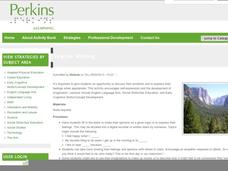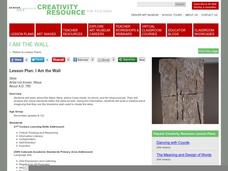EngageNY
Presenting a Research-Based Claim: Visual Aid and Peer Critique
Back to the drawing board. Scholars work on the visual to complement their claim presentations using the Criteria for the Cascading Consequences Chart Visual as a guide. They then practice their presentations with partners.
Curated OER
Art Critic for a Day!
Middle schoolers practice evaluating art by creating a research project and presentation. They use the Internet and library to discover a piece of art or artist whom they feel has an impact on the world of art. Next, they create a...
Curated OER
Elements of Art: Student Assessment
What a neat test! The class is asked to draw and color to create examples of eight elements of art. They focus on each element (line, value, shape, form, space, texture, primary and secondary color) by creating an original piece in each...
Thirteen Ed Online
What is Conceptual Art?
Research, art history, and web page creation! Sounds too good to be true. With tons of links and resources, the lesson provides you with everything needed to engage the class in an amazing art and research activity. They create an art...
Curated OER
Improve Your Spelling with the Visual Thesaurus
Using Visual Thesaurus software, class members participate in a computer-based spelling bee. Then they work in groups to analyze the words and use deductive reasoning to infer spelling patterns. They then present one of their "rules" to...
Odyssey of the Mind
Odyssey of the Mind Curriculum Activity: Performing Arts
The classical arts have made a lasting impact on our society and your advanced learners get to find out why. The activity starts as the children create a list of the arts found in society, they discuss how these art forms impact their...
Curated OER
Visual Vocabulary
Students interpret and name the vocabulary termed acted out by the mime. In this science/language arts/physical education lesson, students are given a set of vocabulary terms to discuss within their group. Next, students place all...
Curated OER
The Visual Thesaurus and the SAT
Demonstrate strategies for tackling unfamiliar vocabulary words in preparation for the SAT. Using Visual Thesaurus computer software, middle and high schoolers interpret contextual clues, solve sample sentence completion questions, and...
Curated OER
Step into the Painting: Social Studies, Literature, and Art
Travel back in American history to the era of slavery and abolition. After reading about the Underground Railroad, young historians examine a painting depicting the event, and write a narrative from the point of view of a person in the...
Curated OER
Visual Aural Impressions
Students view a piece of impressionist art, listen to a piece of jazz music and then write a piece about the picture in the style of beat poets. They compare their writing and look for differences in their perceptions.
Curated OER
Descriptive Writing: Using Art to Inspire description
Write with the senses! Try using art to inspire writers to consider all of the senses. Here, the class is divided in half. Each group looks at one of two images, imagines the senses that would be engaged, and records answers to five...
Perkins School for the Blind
Encouraging Students Who are Blind or Visually Impaired to Express Their Feelings and Explore Imagination
Being expressive in a creative, empathetic, or imaginative way is not only fun, it builds good pre-writing and communication skills. Learners with visual impairments have a roundtable discussion session where several sentence frames are...
UTSA Institute of Texas Cultures
Teaching Through Kamishibai and The Art of Chinese Calligraphy
Young learners discover kamishibai, a popular Japanese storytelling art, and explore how these Japanese folktales illustrate the country's cultural themes and values through discussion and storyboarding.
Teacher's Corner
Seuss Visualizing
Only one thing can compare to the whimsy of Dr. Seuss: a child's imagination. Pair the bouncing narrative of a Dr. Seuss book with your learner's illustrations in a fun reading activity. As you read a selected passage, your class draws...
Curated OER
The Art of Violence
Violence and human suffering, as represented in art and film, are the focus of an investigation of the power of visual images and the moral implications of such representations. Class members examine “Guernica,” Pablo Picasso’s massive...
Curated OER
Lesson Plan: Before and After a Moment in Time
Think about a moment, frozen in time. Now take a critical look at the painting, Better, Homes, Better Gardens. This painting works to provide learners the opportunity to analyze art, critique artist's choices, and write a story inspired...
Cleveland Museum of Art
Japanese Folktales (Asian Odyssey)
The Cleveland Museum of Art presents this interdisciplinary model unit that asks class members to explore how the same themes are presented in the folktales and art of several cultures.
PBS
Women's History: Glass Windows; Glass Ceilings
Discover stories about women's history in beautiful stained glass windows. The second in a three-part series teaches scholars about a famous artistic style of stained glass windows and the influential women that used art to impact...
Curated OER
Medieval and Renaissance Art: Botanical Symbolism
Students study the significance of flowers in art from two periods. In this Medieval and Renaissance art lesson, students research the presence and meaning of botanical illustrations in twelfth, thirtieth, and fourteenth century...
Curated OER
Art Show with the Masters
Students contribute to a classroom art show. In this art appreciation activity, students research the lives and works of artists from different ages. Students write reports, recreate artwork of their researched artists, and participate...
Curated OER
Lesson: I Am the Wall
The Maya created amazing stone carvings and sculptures, but what were they for? Kids analyze the significance and purpose of a Maya stela and then write a creative piece. They imagine they are the stela, and write a story about what life...
Curated OER
Lesson Plan: Finding Your Path
Our art often reflects who we are as individuals and as part of a larger community. The painting Hopi Eagle Dancer reflects the history and culture of the artists who created it. Critical thinkers analyze the piece and then compose a...
Curated OER
1920s Variety Show
To better understand the cultural achievements of the Harlem Renaissance and become familiar with its major figures, class members examine a painting by Aaron Douglas and a poem by Langston Hughes and compare how the artists develop...
Curated OER
Jump-Starting Research with Visual Thesaurus
Learners navigate the Visual Thesaurus to find keywords for research. In this keywords lesson, students use synonyms, hypernyms and hyponyms to find keywords. Learners understand why some searches are effective and some are ineffective.
Other popular searches
- Visual Art Fiber Arts
- Visual Art Graphic Arts
- Visual Arts Art Movements
- Word Art Visual Arts
- Shadow Art Visual Arts

























